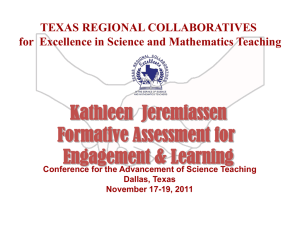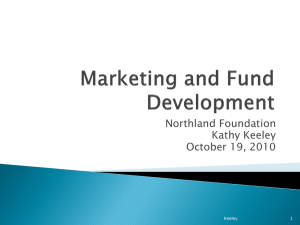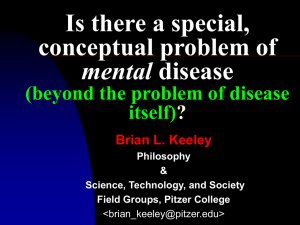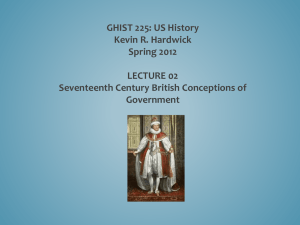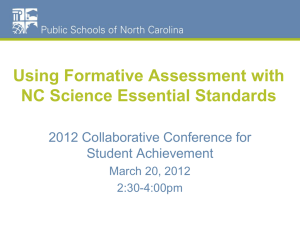Uncovering Student Ideas in Science
advertisement
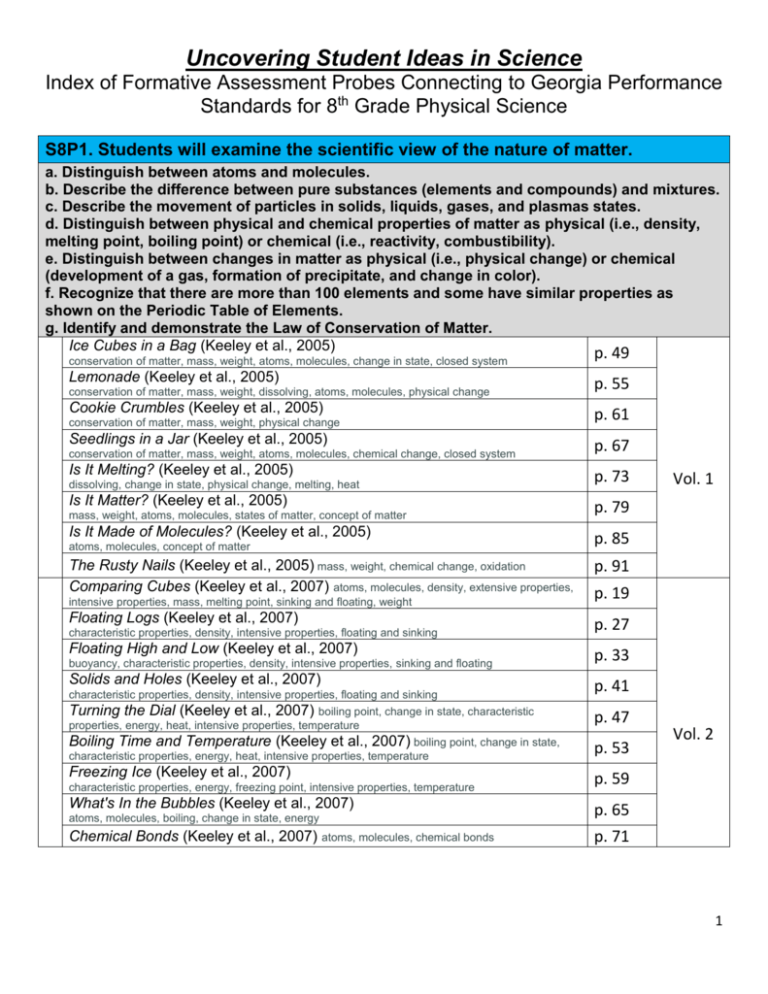
Uncovering Student Ideas in Science Index of Formative Assessment Probes Connecting to Georgia Performance Standards for 8th Grade Physical Science S8P1. Students will examine the scientific view of the nature of matter. a. Distinguish between atoms and molecules. b. Describe the difference between pure substances (elements and compounds) and mixtures. c. Describe the movement of particles in solids, liquids, gases, and plasmas states. d. Distinguish between physical and chemical properties of matter as physical (i.e., density, melting point, boiling point) or chemical (i.e., reactivity, combustibility). e. Distinguish between changes in matter as physical (i.e., physical change) or chemical (development of a gas, formation of precipitate, and change in color). f. Recognize that there are more than 100 elements and some have similar properties as shown on the Periodic Table of Elements. g. Identify and demonstrate the Law of Conservation of Matter. Ice Cubes in a Bag (Keeley et al., 2005) p. 49 conservation of matter, mass, weight, atoms, molecules, change in state, closed system Lemonade (Keeley et al., 2005) conservation of matter, mass, weight, dissolving, atoms, molecules, physical change Cookie Crumbles (Keeley et al., 2005) conservation of matter, mass, weight, physical change Seedlings in a Jar (Keeley et al., 2005) conservation of matter, mass, weight, atoms, molecules, chemical change, closed system Is It Melting? (Keeley et al., 2005) dissolving, change in state, physical change, melting, heat Is It Matter? (Keeley et al., 2005) mass, weight, atoms, molecules, states of matter, concept of matter Is It Made of Molecules? (Keeley et al., 2005) atoms, molecules, concept of matter The Rusty Nails (Keeley et al., 2005) mass, weight, chemical change, oxidation Comparing Cubes (Keeley et al., 2007) atoms, molecules, density, extensive properties, intensive properties, mass, melting point, sinking and floating, weight Floating Logs (Keeley et al., 2007) characteristic properties, density, intensive properties, floating and sinking Floating High and Low (Keeley et al., 2007) buoyancy, characteristic properties, density, intensive properties, sinking and floating Solids and Holes (Keeley et al., 2007) characteristic properties, density, intensive properties, floating and sinking Turning the Dial (Keeley et al., 2007) boiling point, change in state, characteristic properties, energy, heat, intensive properties, temperature Boiling Time and Temperature (Keeley et al., 2007) boiling point, change in state, characteristic properties, energy, heat, intensive properties, temperature Freezing Ice (Keeley et al., 2007) characteristic properties, energy, freezing point, intensive properties, temperature What's In the Bubbles (Keeley et al., 2007) p. 55 p. 61 p. 67 p. 73 Vol. 1 p. 79 p. 85 p. 91 p. 19 p. 27 p. 33 p. 41 p. 47 p. 53 Vol. 2 p. 59 atoms, molecules, boiling, change in state, energy p. 65 Chemical Bonds (Keeley et al., 2007) atoms, molecules, chemical bonds p. 71 1 Pennies (Keeley et al., 2008) atoms, properties of matter Burning Paper (Keeley and Tugel, 2009) chemical change, closed system, combustion, conservation of matter Is It a Solid (Keeley et al., 2008) liquid, solid, properties of matter Thermometer (Keeley et al., 2008) kinetic molecular theory, thermal expansion, thermometer Floating Balloon (Keeley et al., 2008) density, gas, kinetic molecular theory, mass, weight, properties of matter Hot and Cold Balloons (Keeley et al., 2008) conservation of matter, gas, kinetic molecular theory, mass, weight, properties of matter Sugar Water (Keeley and Tugel, 2009) dissolving, mixture, physical change Iron Bar (Keeley and Tugel, 2009) atoms, thermal expansion Nails in a Jar (Keeley and Tugel, 2009) p. 17 p. 23 p. 25 p. 33 Vol. 3 p. 39 p. 45 p. 11 p. 17 chemical change, closed system, conservation of matter, oxidation p. 31 Salt Crystals (Keeley and Tugel, 2009) atoms, crystal, crystalline lattice, ionic bond p. 39 Pizza Dough (Keeley and Harrington, 2010) conservation of mass, mass, weight p. 143 Vol. 4 PS1 S8P2. Students will be familiar with the forms and transformations of energy. a. Explain energy transformation in terms of the Law of Conservation of Energy. b. Explain the relationship between potential and kinetic energy. c. Compare and contrast the different forms of energy (heat, light, electricity, mechanical motion, sound) and their characteristics. d. Describe how heat can be transferred through matter by the collisions of atoms (conduction) or through space (radiation). In a liquid or gas, currents will facilitate the transfer of heat (convection). Warming Water (Keeley and Tugel, 2009) energy, heat, temperature, thermal energy, transfer of energy The Mitten Problem (Keeley et al., 2005) heat, temperature, energy, insulator Objects and Temperature (Keeley et al., 2005) heat temperature Ice-Cold Lemonade (Keeley et al., 2007) energy, energy transfer, heat, conduction, convection Mixing Water (Keeley et al., 2007) energy, energy transfer, heat, conduction, convection, temperature Ice Water (Keeley and Tugel, 2009) energy, phase change, phases of matter, temperature, transfer of energy Rolling to a Stop (Keeley and Harrington, 2010) energy transfer, friction, interaction Gravity Rocks (Keeley and Harrington, 2010) p. 53 Vol. 4 p. 103 p. 109 Vol. 1 p. 77 p. 83 p. 45 Vol. 2 Vol. 4 p. 91 PS1 p. 171 S8P3. Students will investigate relationship between force, mass, and the motion of objects. gravitational force, gravity, gravitational potential energy a. Determine the relationship between velocity and acceleration. b. Demonstrate the effect of balanced and unbalanced forces on an object in terms of gravity, inertia, and friction. c. Demonstrate the effect of simple machines (lever, inclined plane, pulley, wedge, screw, and wheel and axle) on work. Rolling Marbles (Keeley et al., 2008) circular motion, force, inertia, Newton's First Law Dropping Balls (Keeley et al., 2008) acceleration, force, gravity, mass, weight Standing on One Foot (Keeley and Tugel, 2009) force, gravity, pressure, weight p. 71 p. 77 p. 61 Vol. 3 Vol. 4 2 How Far Did It Go? (Keeley and Harrington, 2010) distance, measurement, position Skate Park (Keeley and Harrington, 2010) acceleration, changing speed, constant speed, time, uniform motion Following Jack- Part 1 (Keeley and Harrington, 2010) constant speed, distance, position, speed, time, time intervals, uniform motion Following Jack- Part 2 (Keeley and Harrington, 2010) constant speed, distance, position, speed, time, time intervals, graph, uniform motion p. 15 p. 19 p. 23 p. 27 Go-Cart Test Run (Keeley and Harrington, 2010) clock readings, constant speed, distance, position, speed, time, time intervals, graph, uniform motion p. 31 Checking the Speedometer (Keeley and Harrington, 2010) p. 35 clock readings, displacement, position, ratio, speed, time intervals Speed Units (Keeley and Harrington, 2010) average speed, ratio, speed, units Just Rolling Along (Keeley and Harrington, 2010) constant speed, displacement, speed, uniform motion Crossing the Finish Line (Keeley and Harrington, 2010) average speed, changing speed, instantaneous speed, position, speed, time intervals NASCAR Racing (Keeley and Harrington, 2010) average speed, speed, velocity Roller Coaster Ride (Keeley and Harrington, 2010) acceleration, speed, velocity Rolling Marbles (Keeley and Harrington, 2010) average speed, changing speed, speed, time, time intervals Talking about Forces (Keeley and Harrington, 2010) pushes and pulls Does It Have to Touch? (Keeley and Harrington, 2010) action-at-a-distance force, contact force Force and Motion Ideas (Keeley and Harrington, 2010) active action, constant speed, direction of motion, interaction, passive action Friction (Keeley and Harrington, 2010) contact force, friction, interaction, kinetic friction, rolling friction, sliding friction, static friction A World Without Friction (Keeley and Harrington, 2010) friction, Newton's First Law Outer Space Push (Keeley and Harrington, 2010) Newton's First Law Riding in the Parade (Keeley and Harrington, 2010) Newton's First Law Spaceships (Keeley and Harrington, 2010) changing direction, direction of motion, Newton's First Law Apple in a Plane (Keeley and Harrington, 2010) active action, contact force, gravitational force, interaction, normal force, passive action Ball on a String (Keeley and Harrington, 2010) centripetal force, changing direction, Newton's First Law Why Things Fall (Keeley and Harrington, 2010) action-at-a-distance force, gravitational force, mass, net force, Newton's Second Law, weight Pulling on a Spool (Keeley and Harrington, 2010) net force, Newton's Second Law, rolling friction, tension Lifting Buckets (Keeley and Harrington, 2010) constant speed, net force, Newton's Second Law Finger Strength Contest (Keeley and Harrington, 2010) interaction, Newton's Third Law Equal and Opposite (Keeley and Harrington, 2010) interaction, Newton's Third Law, and normal force Riding in a Car (Keeley and Harrington, 2010) circular motion, Newton's First Law What Will Happen to the Weight? (Keeley and Harrington, 2010) p. 39 p. 43 p. 47 p. 51 p. 55 p. 59 p. 71 p. 75 PS1 p. 79 p. 83 p. 87 p. 95 p. 99 p. 103 p. 107 p. 111 p. 115 p. 119 p. 123 p. 127 p. 131 p. 135 buoyant force, floating, gravitational force, weight p. 149 Weighing Water (Keeley and Harrington, 2010) pressure, weight p. 153 3 Pulley Size mechanical advantage, pulley, simple machine, tension Rescuing Isabelle (Keeley and Harrington, 2010) mechanical advantage, pulley, simple machine, tension, work Balance Beam (Keeley and Harrington, 2010) balancing, mass, weight Lifting a Rock (Keeley and Harrington, 2010) energy, fulcrum, lever, mechanical advantage, potential energy, simple machine, work The Swinging Pendulum (Keeley and Harrington, 2010) pendulum, periodic motion, variables p. 181 p. 185 p. 193 p. 197 p. 201 p. 205 S8P4. Students will explore the wave nature of sound and electromagnetic radiation. Bicycle Gears (Keeley and Harrington, 2010) gears, gear ratio, energy, work a. Identify the characteristics of electromagnetic and mechanical waves. b. Describe how the behavior of light waves is manipulated causing reflection, refraction, diffraction, and absorption. c. Explain how the human eye sees objects and colors in terms of wavelengths. d. Describe how the behavior of waves is affected by medium (such as air, water, solids). e. Relate the properties of sound to everyday experiences. f. Diagram the parts of the wave and explain how the parts are affected by changes in amplitude and pitch. Birthday Candles (Keeley et al., 2005) light, light transmission, vision, light source p. 25 p. 31 p. 37 Making Sound (Keeley et al., 2005) sound, vibration p. 43 Can It Reflect Light? (Keeley et al., 2005) light, reflection Apple in the Dark (Keeley et al., 2005) light, reflection, light transmission, color, vision p. 51 S8P5. Students will recognize characteristics of gravity, electricity, and magnetism as major kinds of forces acting in nature. Mirror on the Wall (Keeley et al., 2008) balanced forces, force, gravity Vol. 1 Vol. 3 a. Recognize that every object exerts gravitational force on every other object and that the force exerted depends on how much mass the objects have and how far apart they are. b. Demonstrate the advantages and disadvantages of series and parallel circuits and how they transfer energy. c. Investigate and explain that electric currents and magnets can exert force on each other. Talking about Gravity (Keeley et al., 2005) gravity Batteries, Bulbs, and Wires (Keeley et al., 2008) complete circuit, electric circuit, electricity Apple on a Desk (Keeley et al., 2008) balanced forces, force, gravity Magnets in Water (Keeley and Tugel, 2009) magnetism Experiencing Gravity (Keeley and Harrington, 2010) gravitational force, gravity, Newton's Universal Law of Gravitation Apple on the Ground (Keeley and Harrington, 2010) gravitational force, gravity, Newton's Universal Law of Gravitation Free-Falling Objects (Keeley and Harrington, 2010) balancing, free fall, gravitational force, gravity, Newton's Second Law The Tower Drop (Keeley and Harrington, 2010) gravitational force, gravity, spherical earth p. 97 p. 57 p. 63 p. 67 Vol. 1 Vol. 3 Vol. 4 p. 157 p. 163 p. 167 PS1 p. 177 4 Nature of science, unifying concepts, and other topics Is It a Theory? (Keeley et al., 2008) theory, hypothesis, scientific law, nature of science Doing Science (Keeley et al., 2008) experiment, nature of science, scientific inquiry, scientific method What Is a Hypothesis? (Keeley et al., 2008) hypothesis, nature of science, scientific inquiry, scientific method p. 83 p. 93 Vol. 3 p. 101 Is It a Model? (Keeley and Tugel, 2009) model p. 73 Is It a System? (Keeley and Tugel, 2009) system p. 81 String Around the Earth circumference, proportion, ratio p. 63 Cutting a Log balancing, center of mass, mass, torque, turning effect, weight p. 189 Vol. 4 PS1 www.uncoveringstudentideas.org Book Titles: Vol. 1=Uncovering Student Ideas in Science Vol. 1 - 25 Formative Assessment Probes Vol. 2=Uncovering Student Ideas in Science Vol. 2 - 25 More Formative Assessment Probes Vol. 3=Uncovering Student Ideas in Science Vol. 3 - Another 25 Formative Assessment Probes Vol. 4=Uncovering Student Ideas in Science Vol. 4 - 25 NEW Formative Assessment Probes PS1=Uncovering Student Ideas in Physical Science Vol. 1 - 45 New Force and Motion Assessment Probes PS2=Uncovering Student Ideas in Physical Science Vol. 2: 39 New Electricity and Magnetism Formative Assessment Probes ***Not yet included on index*** Document compiled by: Ashley Potter & Jeremy Peacock, Northeast GA RESA/Oconee River GYSTC 5


